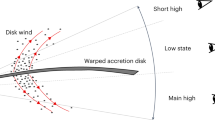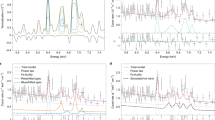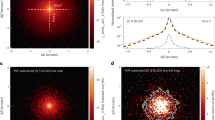Abstract
It is now widely accepted that most galaxies undergo an active phase, during which a central super-massive black hole generates vast radiant luminosities through the gravitational accretion of gas1,2. Winds launched from a rotating accretion disk surrounding the black hole are thought to play a critical role, allowing the disk to shed angular momentum that would otherwise inhibit accretion3,4. Such winds are capable of depositing large amounts of mechanical energy in the host galaxy and its environs, profoundly affecting its formation and evolution5,6,7, and perhaps regulating the formation of large-scale cosmological structures in the early Universe8,9. Although there are good theoretical grounds for believing that outflows from active galactic nuclei originate as disk winds10, observational verification has proven elusive. Here we show that structures observed in polarized light across the broad Hα emission line in the quasar PG 1700+518 originate close to the accretion disk in an electron scattering wind. The wind has large rotational motions (∼4,000 km s-1), providing direct observational evidence that outflows from active galactic nuclei are launched from the disks. Moreover, the wind rises nearly vertically from the disk, favouring launch mechanisms that impart an initial acceleration perpendicular to the disk plane.
This is a preview of subscription content, access via your institution
Access options
Subscribe to this journal
Receive 51 print issues and online access
$199.00 per year
only $3.90 per issue
Buy this article
- Purchase on Springer Link
- Instant access to full article PDF
Prices may be subject to local taxes which are calculated during checkout



Similar content being viewed by others
References
Rees, M. J. Black hole models for active galactic nuclei. Annu. Rev. Astron. Astrophys. 22, 471–506 (1984)
Ferrarese, L. & Ford, H. Supermassive black holes in galactic nuclei: Past, present and future research. Space Sci. Rev. 116, 523–624 (2005)
Crenshaw, D. M., Kraemer, S. B. & George, I. M. Mass loss from the nuclei of active galaxies. Annu. Rev. Astron. Astrophys 41, 117–167 (2003)
Blandford, R. D. & Payne, D. G. Hydromagnetic flows from accretion discs and the production of radio jets. Mon. Not. R. Astron. Soc. 199, 883–903 (1982)
Silk, J. & Rees, M. J. Quasars and galaxy formation. Astron. Astrophys. 331, L1–L4 (1998)
Scannapieco, E., Silk, J. & Bouwens, R. AGN feedback causes downsizing. Astrophys. J. 635, L13–L16 (2005)
Di Matteo, T., Springel, V. & Hernquist, L. Energy input from quasars regulates the growth and activity of black holes and their host galaxies. Nature 433, 604–607 (2005)
Bower, R. G. et al. Breaking the hierarchy of galaxy formation. Mon. Not. R. Astron. Soc. 370, 645–655 (2006)
Menci, N., Fontana, A., Giallongo, E., Grazian, A. & Salimbeni, S. The abundance of distant and extremely red galaxies: The role of AGN feedback in hierarchical models. Astrophys. J. 647, 753–762 (2006)
Shlosman, I., Vitello, P. A. & Shaviv, G. Active galactic nuclei — Internal dynamics and formation of emission clouds. Astrophys. J. 294, 96–105 (1985)
Turnshek, D. A. Properties of the broad absorption-line QSOs. Astrophys. J. 280, 51–65 (1984)
Reichard, T. A. et al. Continuum and emission-line properties of broad absorption line quasars. Astron. J. 126, 2594–2607 (2003)
Weymann, R. J., Morris, S. L., Foltz, C. B. & Hewett, P. C. Comparisons of the emission-line and continuum properties of broad absorption line and normal quasi-stellar objects. Astrophys. J. 373, 23–53 (1991)
Pettini, M. & Boksenberg, A. PG 1700+518 — A low-redshift, broad absorption line QSO. Astrophys. J. 294, L73–L78 (1985)
Schmidt, G. D. & Hines, D. C. The polarization of broad absorption line QSOs. Astrophys. J. 512, 125–135 (1999)
Ogle, P. M. et al. Polarization of broad absorption line QSOs. I. A spectropolarimetric atlas. Astrophys. J. Suppl. Ser. 125, 1–34 (1999)
Rokaki, E. & Boisson, C. Consistency of accretion discs with Seyfert 1 UV fluxes and Hβ emission-line profiles. Mon. Not. R. Astron. Soc. 307, 41–54 (1999)
Smith, J. E., Robinson, A., Young, S., Axon, D. J. & Corbett, E. A. Equatorial scattering and the structure of the broad-line region in Seyfert nuclei: Evidence for a rotating disc. Mon. Not. R. Astron. Soc. 359, 846–864 (2005)
Young, S., Robinson, A., Axon, D. J. & Hough, J. H. Polarization signatures of disc-winds. Astrophys. J. (submitted)
Barvainis, R. Hot dust and the near-infrared bump in the continuum spectra of quasars and active galactic nuclei. Astrophys. J. 320, 537–544 (1987)
Peterson, B. M. et al. Central masses and broad-line region sizes of active galactic nuclei. II. A homogeneous analysis of a large reverberation-mapping database. Astrophys. J. 613, 682–699 (2004)
Murray, N., Chiang, J., Grossman, S. A. & Voit, G. M. Accretion disk winds from active galactic nuclei. Astrophys. J. 451, 498–509 (1995)
de Kool, M. & Begelman, M. C. Radiation pressure-driven magnetic disk winds in broad absorption line quasi-stellar objects. Astrophys. J. 455, 448–455 (1995)
Proga, D., Stone, J. M. & Kallman, T. R. Dynamics of line-driven disk winds in active galactic nuclei. Astrophys. J. 543, 686–696 (2000)
Begelman, M. C., McKee, C. F. & Shields, G. A. Compton heated winds and coronae above accretion disks. I Dynamics. Astrophys. J. 271, 70–88 (1983)
Stone, J. M. & Norman, M. L. Numerical simulations of magnetic accretion disks. Astrophys. J. 433, 746–756 (1994)
Proga, D. & Kallman, T. R. Dynamics of line-driven disk winds in active galactic nuclei. II. Effects of disk radiation. Astrophys. J. 616, 688–695 (2004)
Elvis, M. A Structure for quasars. Astrophys. J. 545, 63–76 (2000)
Oudmaijer, R. D., Proga, D., Drew, J. E. & de Winter, D. The evolved B[e] star HD 87643: Observations and radiation driven disk-wind model for B[e] stars. Mon. Not. R. Astron. Soc. 300, 170–182 (1998)
Young, S. A generic scattering model for AGN. Mon. Not. R. Astron. Soc. 312, 567–578 (2000)
Acknowledgements
This work is based on observations made with the William Herschel Telescope operated on the island of La Palma by the Isaac Newton Group in the Spanish Observatorio del Roque de los Muchachos of the Instituto de Astrofísica de Canarias. This research has made use of NASA’s Astrophysics Data System. We acknowledge financial support from the Science and Technology Facilities Council, UK.
Author Contributions All authors contributed extensively to the work presented in this paper.
Author information
Authors and Affiliations
Corresponding author
Ethics declarations
Competing interests
The authors declare no competing financial interests.
Supplementary information
Supplementary Figures
The file contains Supplementary Figures 1-5 with Legends. These figures illustrate the model output for (1) thermal motions of the scattering elements; (2) different scattering geometries (a colour version of Figure 2 from the main article); (3) cylindrical winds with different outflow and rotational velocities; (4) cylindrical winds with extending to differing vertical heights and (5) cylindrical winds launched from differing radii on the accretion disc. (PDF 421 kb)
Rights and permissions
About this article
Cite this article
Young, S., Axon, D., Robinson, A. et al. The rotating wind of the quasar PG 1700+518. Nature 450, 74–76 (2007). https://doi.org/10.1038/nature06319
Received:
Accepted:
Issue Date:
DOI: https://doi.org/10.1038/nature06319
This article is cited by
-
Missing links in nanomaterials governance: bringing industrial dynamics and downstream policies into view
The Journal of Technology Transfer (2011)
Comments
By submitting a comment you agree to abide by our Terms and Community Guidelines. If you find something abusive or that does not comply with our terms or guidelines please flag it as inappropriate.



